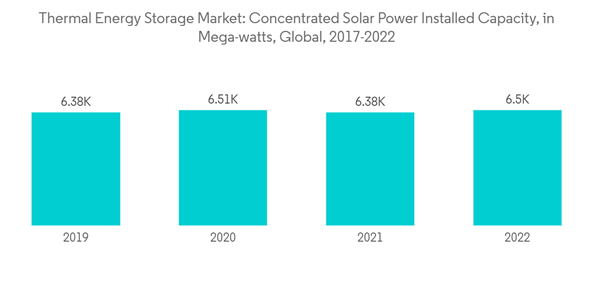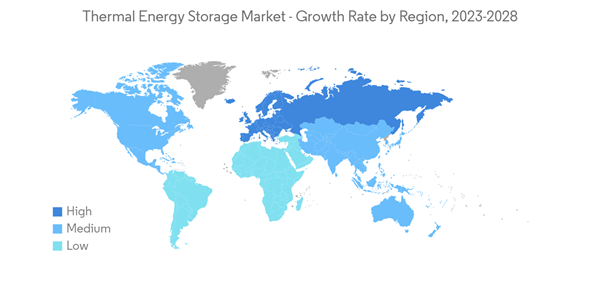The Thermal Energy Storage Market size is estimated at USD 1.12 billion in 2024, and is expected to reach USD 1.51 billion by 2029, growing at a CAGR of 6.25% during the forecast period (2024-2029).
The COVID-19 outbreak negatively impacted the market due to the industrial lockdowns and plummeted power demand in the power generation industry. The thermal energy storage industry players witnessed huge losses in their revenues. The ABENGOA company recorded a revenue of EUR 1,250 million for 2020, a 16% decline from EUR1,493 million in 2019. The thermal energy storage market is likely to boom in the future due to the increased demand for technology in the industrial sector for large-scale heating and cooling applications and the option for an eco-friendly method of saving energy for power generation during peak hours. However, the competition from other energy storage alternatives like battery energy storage is expected to hamper the market's growth in the future.
This product will be delivered within 2 business days.
The COVID-19 outbreak negatively impacted the market due to the industrial lockdowns and plummeted power demand in the power generation industry. The thermal energy storage industry players witnessed huge losses in their revenues. The ABENGOA company recorded a revenue of EUR 1,250 million for 2020, a 16% decline from EUR1,493 million in 2019. The thermal energy storage market is likely to boom in the future due to the increased demand for technology in the industrial sector for large-scale heating and cooling applications and the option for an eco-friendly method of saving energy for power generation during peak hours. However, the competition from other energy storage alternatives like battery energy storage is expected to hamper the market's growth in the future.
Key Highlights
- The power generation application is expected to witness significant growth during the forecast period due to the growing adoption of concentrated solar power (CSP) technology with thermal energy storage systems.
- The research and innovation endeavors to diversify the scope of the technology by the industry players and government organizations create ample opportunities for the market. Very recently, the European Union allotted funds for the technological advancement of thermal energy storage under the Horizon 2020 program.
- Europe is likely to grow faster during the forecast period due to the high demand for seasonal energy storage.
Thermal Energy Storage Market Trends
Power Generation Expected to Witness Significant Growth
- The global installation of renewable power generation and energy security methods has accelerated the need for technologies like concentrated solar power (CSP) in solar power generation. These technologies are often used with thermal energy storage systems in the current scenario.
- The power generation through CSP sources is increasing significantly due to the increasing installation of CSP capacities globally. For instance, in 2022, the total installed CSP capacity was around 6.50 GW, which was 6.37 GW in 2021, as per IRENA. The growth in the technology application was witnessed in the industrial and commercial sectors. Several projects will be added to the solar CSP power generation portfolio, along with thermal energy storage systems.
- In January 2022, the Chinese government announced plans to build 11 CSP projects with thermal energy storage by 2024. The country's state-owned firms are expected to play a leading role in the upcoming projects in consortium with other industry players. They are gigawatt-scale mixed renewable energy projects to be added within two years.
- In June 2023, Vast Solar Pty awarded crucial engineering contracts for the VS1 CSP project in Australia to Worley. The project involves the construction of a 30 MW or 288 MWh CSP plant in Port Augusta, South Australia. This facility will utilize modular CSP tower v3.0 technology of Vast, intending to generate clean, dispatchable, and low-cost power with more than 8 hours of thermal energy.
- Due to these developments, the power generation segment is expected to occupy the largest market share during the forecast period.
Europe Expected to Witness the Highest Growth
- Europe has been installing various thermal energy storage systems for a decade in the urban districts of countries like Spain, Austria, and Northern and Central Europe. The major driver of such a strategic step is the high energy consumption during winters and exploring renewable ways of district heating.
- The region has planned even more large-scale thermal storage projects to meet the ever-growing seasonal and short-term storage demand, with most installations with molten salt technology and underground hot water tanks. They are expected to serve as multifunctional energy hubs for future district heating sources and other applications.
- In August 2022, Kyoto Group in Norway signed a letter of intent (LoI) with Glomma Papp, a cardboard manufacturer, to enter a supply agreement for Kyoto's thermal energy storage molten-salt-based solution, Heatcube. This system is expected to be commissioned in 2023.
- In January 2022, the European Union and the European Investment Bank chose Malta Inc., the grid-scale thermal energy storage provider, to execute the Sun2Store thermal energy storage project in Spain. It is a 1,000-MWh/ten-hour energy storage system combining pumped heat technology with molten salt. The project will likely be developed in partnership with Alfa Laval.
- Such developments are expected to boost the European thermal energy storage market significantly.
Thermal Energy Storage Industry Overview
The thermal energy storage market is moderately consolidated. Some of the key players (not in particular order) are BrightSource Energy Inc., Abengoa SA, Baltimore Aircoil Company, Terrafore Technologies LLC, and SR Energy.Additional Benefits:
- The market estimate (ME) sheet in Excel format
- 3 months of analyst support
This product will be delivered within 2 business days.
Table of Contents
1 INTRODUCTION
4 MARKET OVERVIEW
5 MARKET SEGMENTATION
6 COMPETITIVE LANDSCAPE
7 MARKET OPPORTUNITIES AND FUTURE TRENDS
Companies Mentioned (Partial List)
A selection of companies mentioned in this report includes, but is not limited to:
- BrightSource Energy Inc.
- Aalborg CSP AS
- Abengoa SA
- Baltimore Aircoil Company
- Burns & McDonnell
- SaltX Technology Holding AB
- Terrafore Technologies LLC
- Trane Technologies PLC
- SR Energy
- Vantaa Energy
Methodology

LOADING...










